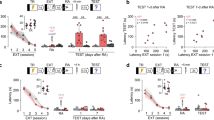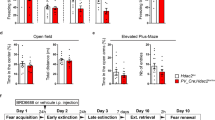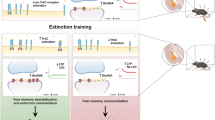Abstract
Treatment of emotional disorders involves the promotion of extinction processes, which are defined as the learned reduction of fear. The molecular mechanisms underlying extinction have only begun to be elucidated. By employing genetic and pharmacological approaches in mice, we show here that extinction requires downregulation of Rac-1 and cyclin-dependent kinase 5 (Cdk5), and upregulation of p21 activated kinase-1 (PAK-1) activity. This is physiologically achieved by a Rac-1–dependent relocation of the Cdk5 activator p35 from the membrane to the cytosol and dissociation of p35 from PAK-1. Moreover, our data suggest that Cdk5/p35 activity prevents extinction in part by inhibition of PAK-1 activity in a Rac-1–dependent manner. We propose that extinction of contextual fear is regulated by counteracting components of a molecular pathway involving Rac-1, Cdk5 and PAK-1. Our data suggest that this pathway could provide a suitable target for therapeutic treatment of emotional disorders.
This is a preview of subscription content, access via your institution
Access options
Subscribe to this journal
Receive 12 print issues and online access
$209.00 per year
only $17.42 per issue
Buy this article
- Purchase on Springer Link
- Instant access to full article PDF
Prices may be subject to local taxes which are calculated during checkout






Similar content being viewed by others
References
Myers, K.M. & Davis, M. Behavioral and neural analysis of extinction. Neuron 36, 567–584 (2002).
Davis, M., Ressler, K., Rothbaum, B.O. & Richardson, R. Effects of D-cycloserine on extinction: translation from preclinical to clinical work. Biol. Psychiatry 60, 369–375 (2006).
Lattal, K.M., Radulovic, J. & Lukowiak, K. Extinction: does it or doesn't it? The requirement of altered gene activity and new protein synthesis. Biol. Psychiatry 60, 344–351 (2006).
Sotres-Bayon, F., Cain, C.K. & LeDoux, J.E. Brain mechanisms of fear extinction: historical perspectives on the contribution of prefrontal cortex. Biol. Psychiatry 60, 329–336 (2006).
Kim, J.J. & Fanselow, M.S. Modality-specific retrograde amnesia of fear. Science 256, 675–677 (1992).
Fischer, A., Sananbenesi, F., Schrick, C., Spiess, J. & Radulovic, J. Distinct roles of hippocampal de novo protein synthesis and actin rearrangement in extinction of contextual fear. J. Neurosci. 24, 1962–1966 (2004).
Falls, W.A., Miserendino, M.J. & Davis, M. Extinction of fear-potentiated startle: blockade by infusion of an NMDA antagonist into the amygdala. J. Neurosci. 12, 854–863 (1992).
Chhatwal, J.P., Stanek-Rattiner, L., Davis, M. & Ressler, K.J. Amygdala BDNF signaling is required for consolidation but not encoding of extinction. Nat. Neurosci. 9, 870–872 (2006).
Szapiro, G., Vianna, M.R., McGaugh, J.L., Medina, J.H. & I., I. The role of NMDA glutamate receptors, PKA, MAPK and CAMKII in the hippocampus in extinction of conditioned fear. Hippocampus 13, 53–58 (2003).
Marsicano, G. et al. The endogenous cannabinoid system controls extinction of aversive memories. Nature 418, 530–534 (2002).
Fukazawa, Y. et al. Hippocampal LTP is accompanied by enhanced F-actin content within the dendritic spine that is essential for late LTP maintenance in vivo. Neuron 38, 447–460 (2003).
Matus, A. Actin-based plasticity in dendritic spines. Science 290, 754–758 (2000).
Fischer, A., Sananbenesi, F., Spiess, J. & Radulovic, J. Cdk5 in the adult non-demented brain. Curr. Drug Targets CNS Neurol. Disord. 2, 375–381 (2003).
Dhavan, R. & Tsai, L.H. A decade of CDK5. Nat. Rev. Mol. Cell Biol. 2, 749–759 (2001).
Nikolic, M. The role of Rho GTPases and associated kinases in regulating neurite outgrowth. Int. J. Biochem. Cell Biol. 34, 731–745 (2002).
Cheung, Z.H., Fu, A.K. & Ip, N.Y. Synaptic roles of Cdk5: implications in higher cognitive functions and neurodegenerative diseases. Neuron 50, 13–18 (2006).
Ohshima, T. et al. Targeted disruption of the cyclin-dependent kinase 5 gene results in abnormal corticogenesis, neuronal pathology and perinatal death. Proc. Natl. Acad. Sci. USA 93, 11173–11178 (1996).
Fischer, A., Sananbenesi, F., Schrick, C., Spiess, J. & Radulovic, J. Cyclin-dependent kinase 5 is required for associative learning. J. Neurosci. 22, 3700–3707 (2002).
Fischer, A., Sananbenesi, F., Pang, P.T., Lu, B. & Tsai, L.H. Opposing roles of transient and prolonged expression of p25 in synaptic plasticity and hippocampus-dependent memory. Neuron 48, 825–838 (2005).
Angelo, M., Plattner, F., Irvine, E.E. & Giese, K.P. Improved reversal learning and altered fear conditioning in transgenic mice with regionally restricted p25 expression. Eur. J. Neurosci. 18, 423–431 (2003).
Li, B.S. et al. Regulation of NMDA receptors by cyclin-dependent kinase-5. Proc. Natl. Acad. Sci. USA 98, 12742–12747 (2001).
Tan, T.C. et al. Cdk5 is essential for synaptic vesicle endocytosis. Nat. Cell Biol. 5, 701–710 (2003).
Tomizawa, K. et al. Cophosphorylation of amphiphysin I and dynamin I by Cdk5 regulates clathrin-mediated endocytosis of synaptic vesicles. J. Cell Biol. 163, 813–824 (2003).
Kim, Y. et al. Phosphorylation of WAVE1 regulates actin polymerization and dendritic spine morphology. Nature 442, 814–817 (2006).
Lee, S.Y., Wenk, M.R., Kim, Y., Nairn, A.C. & De Camilli, P. Regulation of synpatojanin 1 by cyclin-dependent kinase 5 at synapses. Proc. Natl. Acad. Sci. USA 101, 546–551 (2004).
Hawasli, A.H. et al. Cyclin-dependent kinase 5 governs learning and synaptic plasticity via control of NMDAR degradation. Nat. Neurosci. advance online publication 27 May 2007 (doi:10.1038/nn1914).
Nakayama, A.Y., Harms, M.B. & Luo, L. Small GTPases Rac and Rho in the maintenance of dendritic spines and branches in hippocampal pyramidal neurons. J. Neurosci. 20, 5329–5338 (2000).
Hayashi, M.L. et al. Altered cortical synaptic morphology and impaired memory consolidation in forebrain- specific dominant-negative PAK transgenic mice. Neuron 42, 773–787 (2004).
Delamater, A.R. Experimental extinction in Pavlovian conditioning: behavioural and neuroscience perspectives. Q. J. Exp. Psychol. B 57, 97–132 (2004).
Myers, K.M. & Davis, M. Mechanisms of fear extinction. Mol. Psychiatry 12, 120–150 (2007).
Kitagawa, M. et al. Butyrolactone I, a selective inhibitor of cdk2 and cdc2 kinase. Oncogene 8, 2425–2432 (1993).
Fischer, A. et al. Hippocampal Mek/Erk signaling mediates extinction of contextual freezing behavior. Neurobiol. Learn. Mem. 87, 149–158 (2007).
Nikolic, M., Chou, M.M., Lu, W., Mayer, B.J. & Tsai, L.H. The p35/Cdk5 kinase is a neuron-specific Rac effector that inhibits Pak1 activity. Nature 395, 194–198 (1998).
Zhang, Q.G. et al. Akt inhibits MLK3/JNK3 signaling by inactivating Rac1: a protective mechanism against ischemic brain injury. J Neurochem. 98, 1886–1898 (2006).
Desire, L. et al. RAC1 inhibition targets amyloid precursor protein processing by gamma-secretase and decreases Abeta production in vitro and in vivo. J. Biol. Chem. 280, 37516–37525 (2005).
Rashid, T., Banerjee, M. & Nikolic, M. Phosphorylation of Pak1 by the p35/Cdk5 kinase affects neuronal morphology. J. Biol. Chem. 276, 49043–49052 (2001).
Lei, M. et al. Structure of PAK1 in an autoinhibited conformation reveals a multistage activation switch. Cell 102, 387–397 (2000).
Wong, S.T. et al. Calcium-stimulated adenylyl cyclase activity is critical for hippocampus-dependent long-term memory and late phase LTP. Neuron 23, 787–798 (1999).
Wang, H., Ferguson, G.D., Pineda, V.V., Cundiff, P.E. & Storm, D.R. Overexpression of type-1 adenylyl cyclase in mouse forebrain enhances recognition memory and LTP. Nat. Neurosci. 7, 635–642 (2004).
Burgos-Robles, A., Vidal-Gonzalez, I., Santini, E. & Quirk, G.J. Consolidation of fear extinction requires NMDA receptor–dependent bursting in the ventromedial prefrontal cortex. Neuron 53, 871–880 (2007).
Vianna, M.R., Coitinho, A.S. & Izquierdo, I. Role of the hippocampus and amygdala in the extinction of fear-motivated learning. Curr. Neurovasc. Res. 1, 55–60 (2004).
Berlau, D.J. & McGaugh, J.L. Enhancement of extinction memory consolidation: the role of the noradrenergic and GABAergic systems within the basolateral amygdala. Neurobiol. Learn. Mem. 86, 123–132 (2006).
Lin, C.H. et al. Identification of calcineurin as a key signal in the extinction of fear memory. J. Neurosci. 23, 1574–1579 (2003).
Bonhoeffer, T. & Yuste, R. Spine motility. Phenomenology, mechanisms and function. Neuron 35, 1019–1027 (2002).
Edwards, D.C., Sanders, L.C., Bokoch, G.M. & Gill, G.N. Activation of LIM-kinase by Pak1 couples Rac/Cdc42 GTPase signalling to actin cytoskeletal dynamics. Nat. Cell Biol. 1, 253–259 (1999).
Arber, S. et al. Regulation of actin dynamics through phosphorylation of cofilin by LIM-kinase. Nature 393, 805–809 (1998).
Fu, W.Y. et al. Cdk5 regulates EphA4-mediated dendritic spine retraction through an ephexin1-dependent mechanism. Nat. Neurosci. 10, 67–76 (2007).
Berman, D.E. & Dudai, Y. Memory extinction, learning anew and learning the new: dissociations in the molecular machinery of learning in cortex. Science 291, 2417–2419 (2001).
Howell, D.C. Statistical Methods for Psychology (ed. Crokett, C.) (Duxbury Thompson Learning, Duxbury, 2002).
Acknowledgements
We thank B. Samuels for reading the manuscript and for critical discussion, all members of the Tsai lab for helpful advice, M. Nikolic for the pPAK-1T212 antibody and S. Tonegawa for the dominant-negative PAK-1 construct. L.-H.T. is an investigator of the Howard Hughes Medical Institute. This work was partially supported by a US National Institutes of Health grant (NS051874) to L.-H.T. This work was also partially supported by a US National Institute of Mental Health grant MH073669 to J.R., and a Humboldt/Deutsche Forschungsgemeinschaft fellowship to F.S. and A.F., respectively, and by funds from the European Neuroscience Institute Goettingen to A.F. The European Neuroscience Institute is jointly funded by the Medical School University Goettingen and the Max Planck Society.
Author information
Authors and Affiliations
Contributions
The studies were conceived and designed by F.S., A.F., J.R. and L.-H.T. F.S., A.F., X.W., C.S., R.N. and J.R. contributed to the experiments in this work. The paper was written by A.F. and L.-H.T.
Corresponding authors
Ethics declarations
Competing interests
The authors declare no competing financial interests.
Supplementary information
Supplementary Text and Figures
Supplementary Figures 1–6 (PDF 5800 kb)
Rights and permissions
About this article
Cite this article
Sananbenesi, F., Fischer, A., Wang, X. et al. A hippocampal Cdk5 pathway regulates extinction of contextual fear. Nat Neurosci 10, 1012–1019 (2007). https://doi.org/10.1038/nn1943
Received:
Accepted:
Published:
Issue Date:
DOI: https://doi.org/10.1038/nn1943
This article is cited by
-
Peroxisome proliferator-activated receptor-α activation facilitates contextual fear extinction and modulates intrinsic excitability of dentate gyrus neurons
Translational Psychiatry (2023)
-
Involvement of Cdk5 activating subunit p35 in synaptic plasticity in excitatory and inhibitory neurons
Molecular Brain (2022)
-
PV network plasticity mediated by neuregulin1-ErbB4 signalling controls fear extinction
Molecular Psychiatry (2022)
-
Haploinsufficiency of autism causative gene Tbr1 impairs olfactory discrimination and neuronal activation of the olfactory system in mice
Molecular Autism (2019)
-
BDNF release and signaling are required for the antidepressant actions of GLYX-13
Molecular Psychiatry (2018)



